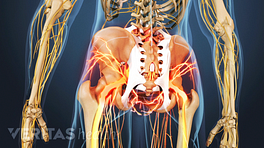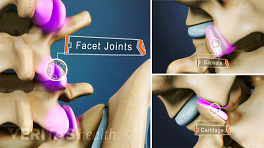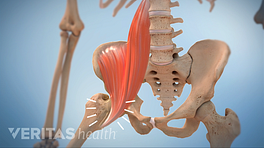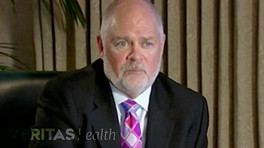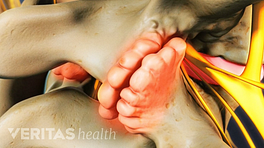Rheumatoid arthritis is a disease that causes destruction of joints in the body. The disease can occur in any joint in the body and is most commonly symptomatic in the small joints in the hands and feet. When rheumatoid arthritis affects the joints in the spine, it is far more common for the neck (cervical spine) to be affected than for the lower back.
See Understanding Hand Pain and Numbness
The most common form of arthritis in the back is osteoarthritis.
Rheumatoid Arthritis Symptoms in the Spine
Rheumatoid arthritis of the spine can lead to neck pain, back pain, and/or pain that radiates into the legs or arms. In advanced cases, the joint deterioration in the spine can lead to compression of the spinal cord and/or the spinal nerve roots.
The symptoms of rheumatoid arthritis in the spine are generally similar to the symptoms of osteoarthritis (also called degenerative arthritis). The range of symptoms is broad and can include any combination of the following:
- Pain is the most common symptom, especially pain at the base of the skull as rheumatoid arthritis most commonly affects the joints connected to the upper cervical vertebrae
- Swelling and warmth in one or more joints, may even be described as burning
- A feeling of local tenderness when the joint of the affected area of the spine is pressed
- Loss of flexibility of the joint(s) in the affected area of the spine
- A crunching feeling when the joint is moved (called crepitus), particularly notable in the neck (although this crunching also happens in normal joints)
- Headaches, related to cervical rheumatoid arthritis
- Pain that radiates down one or both arms, indicating that a cervical spinal nerve root is affected
- Pain that radiates down one or both legs, indicating that a lumbar nerve root is affected
- A change in the ability to walk can signal increasing pressure on the spinal cord.
- Sensations of tingling and/or weakness in the arms or legs, or a loss of coordination or ability to walk, which may be an indication that the spinal cord is affected.
- Any type of difficulty with bowel or bladder control, such as incontinence or inability to urinate, or lack of ability to control the bowels
Symptoms of bowel or bladder dysfunction or change in the ability to walk or move the arms are serious medical symptoms and immediate medical attention should be sought.
See When Back Pain May Be a Medical Emergency
Rheumatoid Arthritis Treatment
The goals of treatment for rheumatoid arthritis in the spine are primarily to:
- Reduce or eliminate the pain
- Maintain the ability to function in everyday life
- Reduce or slow the progression of the disease.
For the vast majority of people, treatment is nonsurgical and will include one or a combination of physical therapy and exercise, medications, diet and nutrition, and possibly alternative or complementary forms of care. Surgery for rheumatoid arthritis in the spine is rare.
For more in-depth information, see Rheumatoid Arthritis and Low Back Pain on Arthritis-health.com

